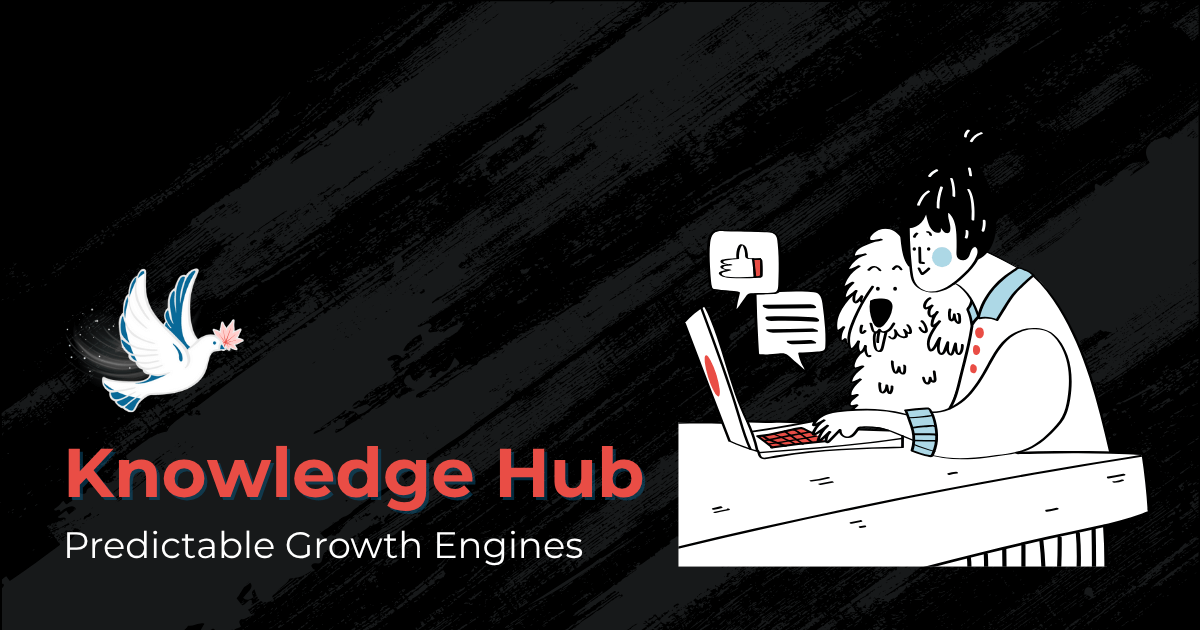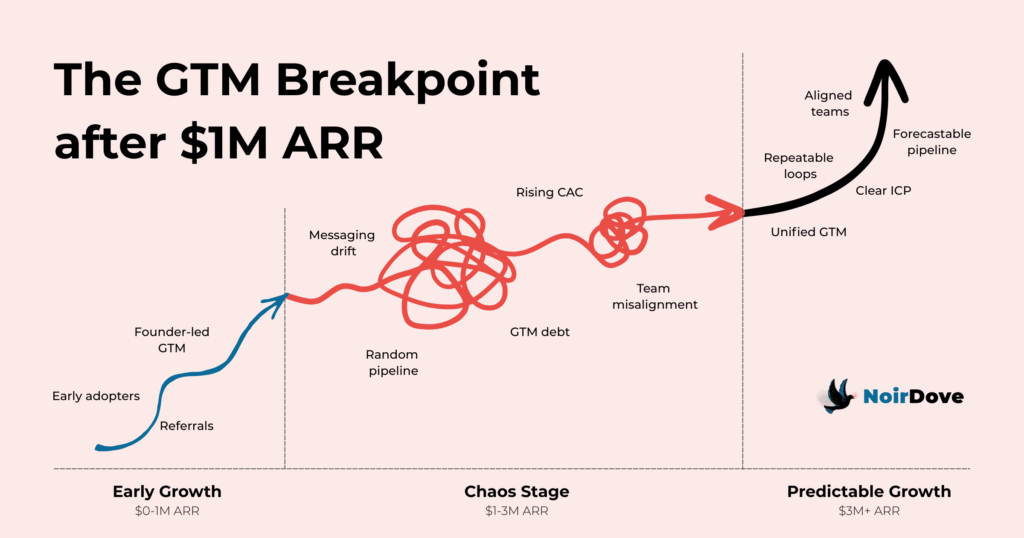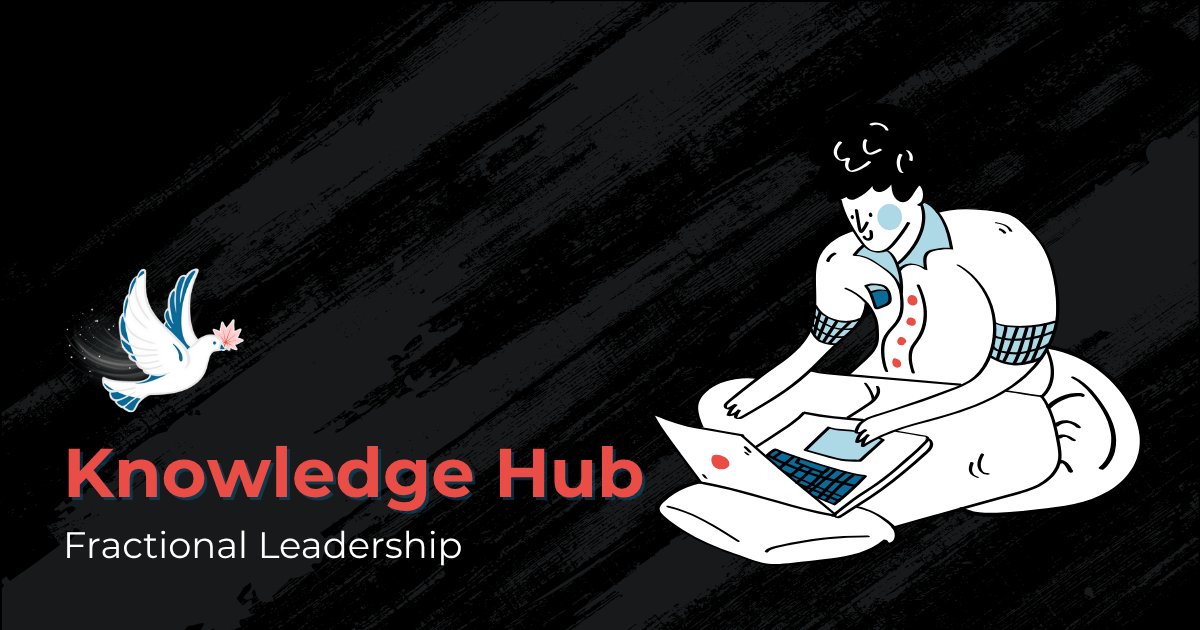Why Growth Feels Random After $1M ARR

After $1M ARR, your growth stops being effort-driven and becomes system-driven. The tactics that got you here do not scale past this stage. Founder hustle creates early revenue but can’t create repeatable revenue. That’s why even when the product is strong, growth begins to feel inconsistent.
At this stage, complexity inside the business increases faster than clarity. More channels, more roles, more tools, more customer types. And without a unified system for GTM, every team starts operating in their own lane.
This creates structural noise that shows up as unpredictable pipeline, rising CAC, and inconsistent sales velocity.
1. Founder-Led GTM Stops Scaling
Founders carry GTM on their backs in the early days, pen the copy, run the calls, close the deals, and tweak the pitch. This works because the founders understand the problem deeply. But at $1M ARR, founder bandwidth becomes the ceiling.
When the founders step back, nobody else can recreate the magic because the system was never codified. That leads to inconsistent outbound, inconsistent messaging, and inconsistent results.
A founder can scale effort; a company can only scale systems.
2. The Team Is Busy But Not Aligned
At $1M ARR, you finally have a marketing person, a few sales reps, maybe a product marketer or SDR. Each is doing their best. But “best” does not mean aligned.
Marketing optimizes for leads.
Sales optimizes for deals.
Product optimizes for feedback.
None of them optimizes for one another.
This creates inner friction that founders feel as :
- random pipeline surges
- dead months without explanation
- deals stuck for weeks
- the risk of multiple versions of the story being out there from prospects who’ve heard about it
It is not a people problem, it is a system problem.

3. Pipeline Is Built on Activity, Not a Predictable Loop
Before $1M, pipeline is a result of “doing things”; posting, emailing, calling, demoing. Whereas after $1M, this activity-first mindset collapses. And without demand loops and conversion loops, business becomes dependent on how loud or how often someone pushes.
The Pipeline feels random because it is random.
Predictable pipeline only emerges when:
- the same story is leveraged across all channels
- one ICP is pursued systematically
- one attribution path shows what works
- one feedback loop informs product and messaging
Most companies have assets. Few have an engine.
4. CAC Starts Rising Because GTM Debt Appears
GTM debt is the silent killer.
This results from murky ICP, watered-down messaging, bloated funnels, and scattered channels. At $1M ARR, this debt shows up as rising CAC.
You spend more to acquire the same customers.
Campaigns cease to convert at the same rate.
Outbound feels harder.
High CAC is not a marketing problem; it’s a GTM architecture problem.
5. Internal Signals Replace Market Signals
Before $1M, you build on customer pain. After $1M, teams often start building on internal assumptions.
- Product ships new features, but not what customers will pay for.
- Sales chases bigger logos, not the true ICP.
- Marketing produces more content, not what moves pipeline.
Market reality and internal reality drift apart. This drift creates random outcomes.
6. You Have Inputs, But Not a System That Compounds
The real shift after $1M ARR is this:
“You do not need more motion. You need more compounding.”
Compounding GTM means:
- every action strengthens the next
- every channel amplifies the others
- every customer creates more customers
- every win improves your system.
Without compounding, your company runs on horsepower instead of flywheels. And horsepower always burns out.
Conclusion
Growth feels random after $1M ARR. Not because the product is weak, the team is failing, or the channels are broken. It feels random because you’ve outgrown “activity-driven growth” but have not yet built a “system-driven growth engine.”
The ones that scale from $1M to $10M are not the ones doing the most. They are the ones who finally build a system that does the heavy lifting for them.
Frequently Asked Questions (FAQs)
1. Why does growth feel smooth up until $1M ARR, then suddenly chaotic?
That is because early growth is driven by founder hustle, referrals, and early adopters. Growth post-$1M ARR needs systems, alignment, and repeatability. Most companies do not have those built yet.
2. Does this unpredictability suggest that my marketing or sales team is doing something wrong?
No, not usually. It is almost always an indication that your GTM system isn’t unified. The teams are working hard, but without a single narrative, one ICP, and one operating rhythm, the output becomes inconsistent.
3. Can adding more channels or spending more on paid ads fix random growth?
No. More channels usually worsen things. You need to lay a clear foundation, have better positioning, get a predictable pipeline engine, and then feedback loops before expansion.
4. How do I know whether I’m suffering from GTM debt?
If your CAC is going up, if pipeline swings month to month, and sales cycles keep getting longer, you are carrying GTM debt. It shows up in lagging metrics long before symptoms appear.
5. What is the fastest way to make growth predictable again?
Start with the realignment of ICP, messaging, positioning, and GTM architecture. Then, integrate your demand, conversion, and retention loops into a single connected system. Predictability happens through compounding-not tactics.


